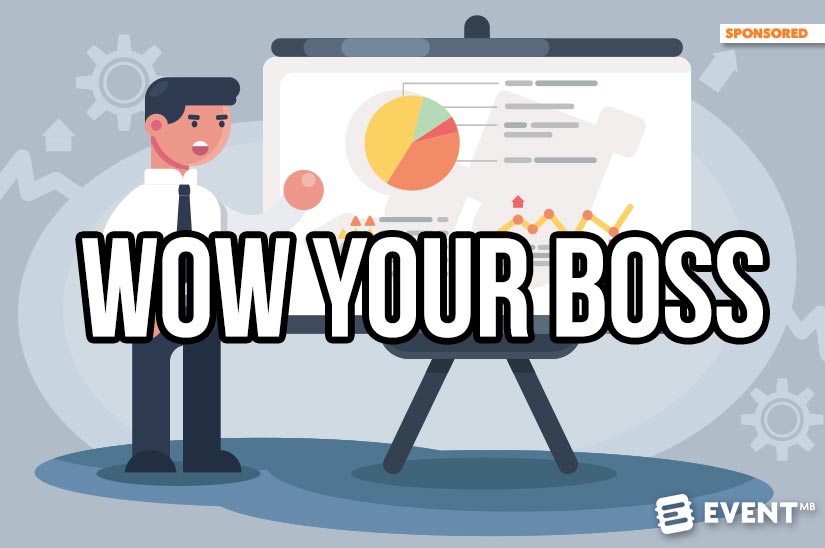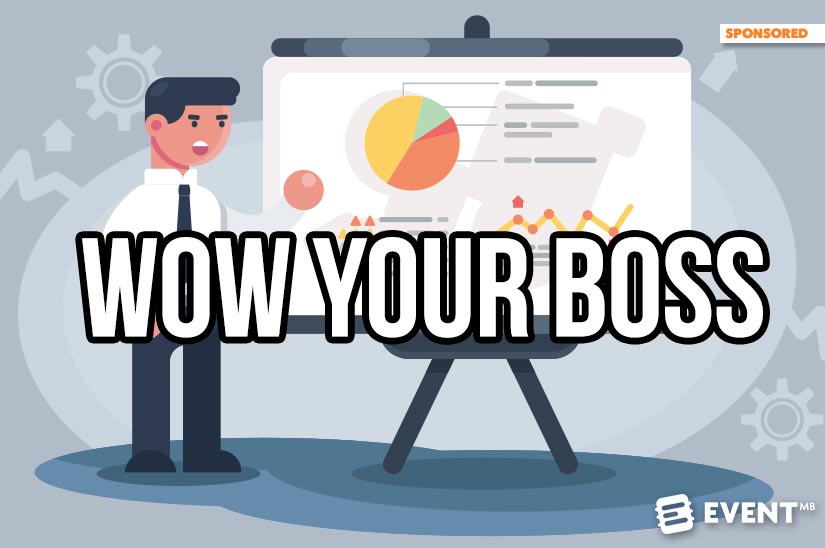This is a sponsored post by Omnience. More information about Event Manager Blog’s sponsored posts.


You walk into your Monday meeting to kick off planning for your next event and your boss asks, “How did the last event go?” It isn’t enough to just reply, “It went great!” without any supporting metrics or data to prove the success. You are accountable at this very moment. Event metrics are essential in justifying effective costs on marketing events to the leadership team.
How do you measure your events? Where do you begin?
It’s much easier than you think. Don’t let the data or analyses worry you. Think of it as translating your definition of event success into a language your leadership team understands: Return on Investment.
This post will explore:
- the key metrics you should be measuring
- the tools and calculations you need
- the information your leadership team needs to prove the value of every event
Key Metrics Every Leadership Team Is Interested In and the Tools to Measure Them
If your leadership team has shared their business goals and key performance indicators for the event with you, then you should use these to shape your reporting; tailoring what you share to their interests. If they haven’t, be prepared with all of the following:
The significance of tracking registration trends can show how your event is performing compared with year-over-year rates of previous ones. Do you get most of your registrations on the last day of early-bird registration or the last day before close? Knowing what historically has been your best-selling time will help you understand how your event ticket sales are performing and whether you need to increase your marketing spend or efforts to sell more tickets.
Knowing your historical data also helps you understand revenue flow and what you can expect financially in the ticket selling cycle.
Pro tip: in addition to getting a better understanding of your current sales as it applies to historic trends and measuring where you are in the sales cycle, using a call to action that gets potential registrants in the sales funnel earlier giving you more time to sell to them. This additional revenue could take the form of more tickets, upgrades, bonus activities, materials, or even swag for popular branded events.
Measurement tools: Excel or some other graphing app is a basic tool for this sort of analysis. Use your registration software (some may even have these abilities within them negating the need to use outside spreadsheets and graphs) to pull the registration numbers by week. Chart the registrations against event milestones like the introduction of early-bird pricing or last day for the discount. Review previous year’s data against your current.
What management is looking for: Obviously management is looking for an increase in revenue with each event. However, it’s just as important to them to understand revenue flows as some of the budget may be affected by this data.
Event Check-in
What’s the percentage of people who buy tickets to your event against those who actually check in? While a small percentage of no-shows is to be expected, if there’s a high number of people who do not show up for the event, it’s indicative of a larger problem. If your tickets are pre-paid and non-refundable, it’s likely your leadership team will care little about this stat. But, if the tickets are reserved online and then paid at the door, the difference in headcount and revenue could be significant. In this case, the caterer likely prepared for your guests based on registration numbers and if they don’t show up, you’re paying for their meal anyway.
Pro tip: Keep in mind you may have virtual registrations to track and apply to these numbers as well. Which gap (of registered attendee versus participating attendee) is higher? Virtual or in-person? Note that if you encouraged people to register virtually, even if they couldn’t attend so that they could get the recording, your online attendee rate will likely be lower.
Measurement tools: This data can be simply accessed through most event apps but should also be compared to previous years. If there are great fluctuations in the percentages of no-shows, further exploration of external factors may be helpful such as weather conditions, airline strikes, safety concerns, etc. If such factors exist(ed) they should be noted.
What management is looking for: A low rate of no-shows. If you have a virtual component, they may also be looking at that number. Online attendees are more likely to attend a future event similar to one they participated in online than those who did not participate.
Net Promoter Score
This is a popular analytic with leadership teams and it is easy to derive. Simply ask your attendees on a scale of 1-10 (one being highly unlikely, ten being very likely), how likely they are to recommend your event to a friend or peer. Then grade your results.
- Detractors: score your event between a 1-6. It is not likely they will share.
- Passives: grade between a 7-8. They enjoyed the event but probably won’t “socialize” it or share it with someone.
- Promoters: score your event between a 9-10. They’re highly motivated to share.
Next, subtract the percentage of detractors from the percentage who are promoters. This number is your net promoter score (NPS).
What management is looking for: It’s generally agreed that anything above 0 is good as in your event is seen in a favorable light; above 50 is excellent, and above 70 deserves the title “world-class” in the eyes of the audience.
Measurement tools: A survey tool/app, written exit survey, email exit survey, website survey, or phone call/personal exit survey can give you these results very quickly. A spreadsheet can help you tabulate results without the heavy lifting of calculations.
Social Media Metrics
Social media metrics can be tricky because it’s a bit like going down the rabbit hole. When presenting them to executive leadership, it’s important to show them what they are most interested in. If brand awareness is their thing, track mentions on all of your channels. If they’re more interested in ticket sales, track the URLs posted on social media that brought traffic to your event landing page. With social media metrics, more than any other form of event analytics, you should show what is most applicable to their idea of success.
Measurement tools: This will largely depend on what numbers are important to you. Brand awareness and mentions can easily be tracked through social media monitoring software or the analytics available on most social apps.
If you want to track how many ticket sales came from your social media interactions, create a URL specific to each channel you are advertising it on and track your click-throughs in that space. You can also use a Google Analytics campaign and unique URLs to watch referral traffic from social media sources.
Pro tip: Most savvy marketers understand that not all social media mentions are equal. For instance, someone in a photo op with your brand is nice but likely won’t convince someone to buy from you alone. Whereas a comment on social about how fun your event was and how they’re going back next year does drive interest. Therefore, it’s important to measure the sentiment of social media when analyzing its impact. You’ll likely need a third-party resource for this as most built-in social media analytics can’t quite achieve this yet. Omnience Ontrac solution can help you better understand the sentiment behind your mentions for even stronger analysis.
What management is looking for: Leadership is often looking for return on investment or thinking ‘was the time/resource investment worth it?’ Time on social media can be difficult to quantify. Give context to the numbers you are presenting through historical analysis (“It was this, now it’s this”) and illustrations of people engaging with your event brand and sponsors.
Share with them examples of any social media reports you provide the sponsors. For instance, if you create a “mentions” report to help sponsors see value from your social media interactions, make sure you share these examples with leadership. They will likely be pleased that people are talking about their event and sponsors are getting visible marketing mileage from it. Do not try to make social media gurus out of your leadership team. They are more interested in why those numbers are important and how they translate into revenue than they are the numbers of followers themselves.
Email Marketing
If you run an email campaign, it’s extremely important to track click-throughs and calls to action. Did your audience do as you expected them to in the campaign? Did it increase the number of tickets purchased? Did it get more people engaged with your website content?
For an even greater impression on the management team, show them how your data powered your marketing. For instance, if you discovered in your email campaign that a certain type of content motivated action among your audience and you reformulated your approach based on that to drive more intended action, share those stats and the methodology behind it. It’s likely your leadership team will appreciate your agility in adapting to the preferences of your potential ticket buyers.
Measurement tools: Most email marketing technology can provide insights into open rates, click-throughs and actions taken. Some of the more advanced drip marketing programs will also allow you to annotate “moments” so you can see how your marketing affects your campaigns. For instance, you can note when you changed your subject line content approach or something else that may affect open rates.
What questions/answers leadership is looking for:
- Is the investment paying off?
- Are email recipients doing what you ask?
- Are you moving the dial with your email marketing?
Brand Impact
Often, ticket purchases are based on event reputation. And event reputation has a direct impact on the organization behind the event and vice versa. That’s why it’s important to track brand impact through lenses like thought leadership and approachability. What words are synonymous with your event and what types of people do potential ticket buyers think come to your event? Whenever you can show that your efforts have had a positive impression on your organization’s branding, they should be shared with the leadership team.
Measurement tools: Surveys and social media are the best ways to understand the sentiment about your organization and your event. In surveys, you can directly ask about sentiment, while social media allows you to listen to people speaking about your event, company, or other influencing factors in their decision to attend or not. Using a listening dashboard and a wide variety of keywords directly and indirectly associated with the things that matter most to you will help you get a pulse of how people feel about you.
What management wants to see: They want to see an increase in the excitement surrounding your brand. This could take the form of increased social media mentions, referrals, and ultimately sales. Track numbers for the first quarter after the event as well. Show leadership what you’re doing to stay engaged and keep the buzz going (i.e., an online community, brand ambassadors program, etc).
Sponsor Interest
This is a good one to track because it directly correlates with something very valuable to the executive team – revenue. It also speaks indirectly about what was mentioned above, brand impact. No sponsor wants to be associated with an organization that is not in their best financial interests. Look at the number of companies distancing themselves from the NRA recently because of concerns over gun safety and the public relations involving the issues. To be in demand from a sponsorship perspective, your event (and the organization behind it) is seen as good positioning for the sponsor’s brand.
When sharing sponsorship information, it’s a good idea to show year-over-year numbers and analyze the differences between those companies that increased their sponsorship dollars and those that did not. What similarities do the increasing sponsors have in common? What is different between them and the stagnating investing sponsors?
Measurement tools: Compare your current sponsorship information to that of years in the past. What changes do you see? You can do this through a simple spreadsheet or through event management software with sponsor management features. Looking at the data in a visual, graphical representation can help you assess trends more quickly than looking at raw numbers. Also, note anything that may have disrupted a level of sponsorship such as a business having a difficult year financially. You don’t want that to negatively affect your analysis since that investment change is beyond your control.
What management wants: increasing sponsorship interest and possible mutually beneficial partnerships that can be leveraged for even greater future revenue.
Cost Per______
The blank in this metric depends on your attendees. Is your event a user’s group? In that case, the blank would be “customer.” Is your event merely a fun branding exercise? Then it’s cost per “attendee.” Or is this event a sales opportunity to gain more customers? Then the calculation is the cost per sale.
Measurement tools: Most of these will be calculated by figuring out what was spent on each person and what kind of revenue and additional (future) revenue was secured because of the event. For instance, if this is a sales opportunity, revenue would include the ticket price, any revenue made through branded item sales, and those who converted from attendees to customers at the event and over time.
Pro tip: It’s easy to calculate this number based solely on tickets but there’s more revenue involved. As mentioned above, branded souvenir items and thought leadership materials may bring in revenue; a training program pitched at your event could also bring in additional revenue. Offering coupon codes to attendees for (future) services pitched at your event can help you track purchases made after your event. It’s important you find a way to track revenue due to your event that comes in afterward.
In Conclusion
As you define your journey to maximize the effectiveness of your events, it’s important to create visualizations of the data that provide a competitive advantage when presenting your event’s investment in all areas. The data needs to be relevant and highlight key metrics your boss is looking for. Don’t bog them down with superfluous data just because you have it. Highlight the data as simplistically as possible – executive summaries in current and historical context, showcase success, and areas of improvement across all events. Be the rockstar planner, with the results and data to match. That way, when you are asked, “How did your event go?” You can confidently reply, “It went GREAT! Let me share the results and strategic insights on how we increased ROI!”






